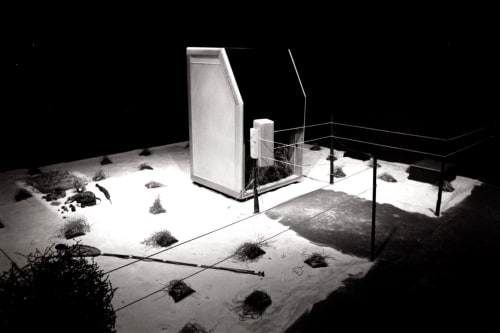The Newport Harbor Art Museum’s exhibition of four sound installations included one piece each by Michael McMillan, the John Doe Co., Michael Brewster and Dr. Who? The first two incorporated sound as an adjunct to complex visual tableaux, while the latter dealt with sound in a relatively purist manner, focusing the viewer on the phenomenon in itself.
All spaces are enclosed, nearly soundproof, and are meant to be experienced alone or with one or two others, so that distractions are minimized. A small entrance to McMillan’s piece forces one to bend over and experience an Alice-in-Wonderland spatial distortion. Once inside, the sense of spatial distortion is reinforced; standing upright, we confront at eye level a detailed, small-scale artist’s studio seen from the outside. Neon lights, beer signs, run-down 1930s buildings, the “Modern Cleaners,” the “Proud Smoke” billboard, the “French Massage Parlor,” all convincingly evoke a specific slice-of-life. The recorded sounds of traffic noises, television admonitions to the Christmas shop early and party noises from the artist’s studio are actual scale, so to speak, and contemporary, adding an odd dimension of reality to the small tableau. The recorded sounds lend credence to the illusion that we are indeed gargantuan intruders in a lilliputian setting.
McMillan has worked with special effects for films and television, and his attention to detail is impressive. Choosing the artist’s studio as subject matter, he draws attention to the artist’s living conditions in an indirect social comment. Because the sound is not clearly discernible, we must pay close attention in order to hear it, and in so doing become aware of various levels of reality—indoor, outdoor, lower, higher, human, media, scale.
Inside the John Doe Co.’s installation we confront an incongruous juxtaposition of an electronic mah-jongg game in the midst of what appears to be a primitive ritual ground in the desert. On a bed of sand, patches of living grasses tied together are dispersed at regular intervals. In one area dead animals and withered vegetables are ceremonially arranged. Putting a quarter in the machine brings on a sound and light show, apparently of an extraterrestrial vehicle accompanied by magnified desert night sounds which can be apprehended either as natural or synthetic, space-age sounds. Although the John Doe Co.’s unexpected intermingling of nature and technology is jarring for many viewers, the artist sees the two as aspects of the same thing. (He compares picking up nuts and bolts to picking up rocks.) In this work both machine and desert are alternately and equally alive and dead.
Entering Brewster’s austere white room, illuminated by two bare light bulbs, we see, centered on the opposite wall, two circular black forms. These are speakers generating a single sound wave which reverberates back and forth from the walls. By moving through the space, I experienced the undulating, wavelike nature of sound actually passing through the top of my head. Movement is essential to the experience of the sound as a palpable physical entity, which becomes more intense near the speakers, and less in other areas. Brewster manipulates the space in a sculptural manner through the sound. I had a strong sensation of my body as part of a space-time continuum. Feeling the sound pass through me, I seemed not separate from the space surrounding me, but of the same substance. Apprehending the multiplicity inherent in a single sound wave, I felt the space at once as quiet and empty, moving and alive.

